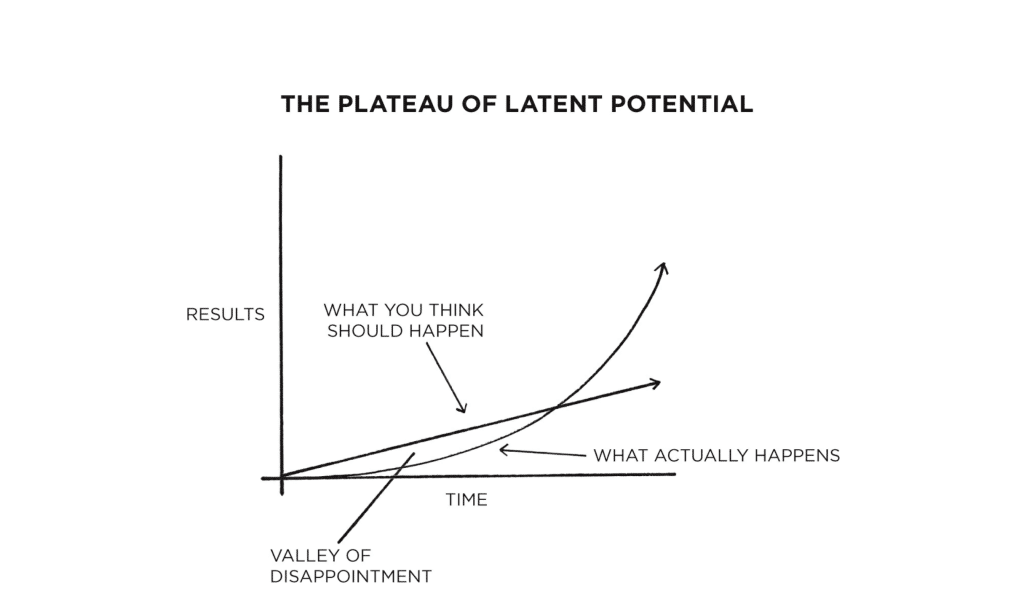Atomic Habits Summary and Review – How To Form and Maintain New Habits

This post may contain affiliate links. I only recommend products I trust or personally use. Please read our disclaimer for more info.
I was never really very good at building habits.
Sure, I could start going to the gym or eating healthy for a few weeks, but it never lasted. I would always eventually give up and go back to my old ways.
I tried all sorts of different things to try and stick with my new habits, but nothing really seemed to work for me. It didn’t matter if it was trying to read more books, eat healthier, or even work on my business more. I couldn’t stick with anything, and frankly, it was infuriating.
It started to feel like something was wrong with me.
But then I read James Clear’s book Atomic Habits and everything changed.
Suddenly I was able to stick to new habits, and start to see progress in things I had always struggled with before. Don’t get me wrong, I’m still not perfect by any means, but Atomic Habits was truly one of the most helpful books I have ever read.
I might even go as far as to say… life-changing. (I know… I know… dramatic. But it’s true!)
So in this post, I want to share with you what I’ve learned from the book and give you guys my personal review and explain how I think it can help you accomplish your goals in life too.
But before we get too deep in, let me give you a quick Atomic Habits summary so you know what to expect if you decide to read the book for yourself.

Atomic Habits Summary in a Few Sentences
Atomic Habits is a book written by James Clear that talks about how we form habits and why some habits are harder to break than others. The book is based on the idea that our actions are determined by our habits, and that if we can change our habits, then we can actually change our lives.
The book goes into detail about how we can change our habits, and provides practical tips and examples to help us form new, better, long term habits. Atomic Habits also debunks some of the myths about habit formation, and provides a framework for understanding why some habits are harder to break than others. Overall, I found Atomic Habits to be an extremely helpful and practical book that has helped me change my own habits, and I believe it can help you too.
Who is James Clear and What Makes Him a Habit Expert?
James Clear is a writer and entrepreneur who focuses on the science of habit formation and human behavior. He has a degree in biochemistry from the University of Cincinnati, and he has also studied neuroscience and psychology at Harvard University.
In addition to his academic credentials, James Clear has also written for publications like The New York Times, Time magazine, and Entrepreneur magazine. He is also the author of two other popular books: Making Small Talk Sexy and How to Build Self-Discipline.
So basically, James Clear knows his stuff when it comes to habits. He’s not just some random guy giving advice – he’s actually studied the science behind habit formation, and he’s applied it to his own life with great success as you’ll find out in the introduction of the book.
I also admire that in Atomic Habits James Clear gives credit to all the minds who he references and admits that his book is just a collection of discoveries by psychologists and brilliant thinkers with his own perspective and knowledge added.
Who Should Read Atomic Habits?
I think anyone who struggles with forming or maintaining new habits will find Atomic Habits to be helpful. The book is especially useful for those who have tried and failed to change their habits in the past. If you’ve ever felt like you can’t stick to a new diet, or can’t seem to get yourself to go to the gym, then this book is definitely for you.
Atomic Habits will help you understand why you haven’t been successful in the past, and will give you the tools you need to finally start forming long-term, sustainable habits.
What does Atomic Habits actually teach you?
Atomic Habits offers an easy way to build good habits and break bad ones. James Clear explains how every habit follows a 4-step pattern that consists of stimulus, craving, response, and rewards. And explains that by better understanding how habits work and fully understanding and utilizing the laws he lays out for building and maintaining habits, you can hone the atomic habit process to achieve the greatest changes possible in your life.
(Don’t worry, if none of that made sense we’ll cover it a little more in-depth as we go on.)
But, let’s start by covering the basics.
What exactly ARE atomic habits?
Atomic habits are small, everyday actions that compound over time to produce massive results. They are the things you do (or don’t do) on a daily basis that determine your success or failure in whatever you are trying to achieve.
For example, if you want to be a writer, your atomic habit could be to write 500 words every day.
If you want to be a better investor, your atomic habit could be to read one investing book per month.
If you want to lose weight, your atomic habit could be to walk for 30 minutes every day.
Basically, you accomplish your goal identity (being a writer, being a good investor, or being healthy) by performing these seemingly small, but atomic habits. Magically, much like compound interest, these atomic habits compound over time to produce massive results and help you achieve your goals. That is if you don’t quit.
Unfortunately, most people quit before they ever get a chance to see the fruits of their labor.
Which brings me to one of the first concepts introduced in the book.
The Plateau of Latent Potential
The plateau of latent potential is the period of time between starting a new habit and actually seeing results from that habit.

For example, let’s say you start going to the gym 3 times per week. For the first few weeks, you will probably see some results. You might lose a few pounds, or even gain a little bit of muscle.
But, after a few weeks, your results will start to plateau. You won’t see any more weight loss or muscle gain for a while, and this is where most people give up.
They think that because they aren’t seeing results, the new habit isn’t working. But that’s not true. The reason you stopped seeing results is that you are currently in what the plateau of latent potential refers to as “the valley of disappointment”.
This is the painful part of starting something new where what you expected to happen is not happening.
And don’t worry, you aren’t alone! We all fall victim to this mindset. I know I sure did.
“I have been dieting for a week, why haven’t I lost ten pounds yet?”
“I cut down on my spending, why am I not financially stable yet?”
This phase is when the new habit is starting to pay off, but you haven’t actually seen the results yet. James references this as “stored energy”. The work you are doing is not being wasted, it is just being stored.
We like to believe that our inputs produce equal outputs, but unfortunately, the reality is, more times than not, progress is not linear. The work we do at the start is not always reflected in the results we see right from the start.
It can be frustrating, but it is essential to understand if you want to make it through to the other side of anything you start.
The good news is that if you can stick with your new habit long enough to get through the valley of disappointment, you will eventually reach your goals.
You have to put in the work for a long time before you see results. This is why most people fail to stick with their new habits. They just give up too soon.
So, if you want to be successful with your new habit, you need to learn to push through. You need to keep putting in the work, even when you don’t see results, and it will pay off in the end.
So How Can Atomic Habits Help You Achieve Your Dreams?
The sad truth is that most people never reach their goals because they give up before the compounding effect ever takes hold. They expect to see results immediately, and when they don’t, they give up. (more on this later)
I have seen it again and again and again. In fact, I was even one of those people.
Like Matthew Kelly Wrote in his book “The Long View” –
“Most people overestimate what they can do in a day, and underestimate what they can do in a month.”
By reframing your mindset to prepare you for that lag time between your work and your results, you will eventually reach a point where your habits are working FOR you npt against you, and the results will start to snowball.
For example, let’s say you want to write a book. In the first week, you might only write 5,000 words (which is still an impressive feat). But it is nowhere near enough for a book. But because of your newfound healthy habits, by the end of the year, you will have written 260,000 words. Which is more than two average-sized novels.
The same is true for any goal you want to achieve. If you can stick with your atomic habits long enough and make it through the plateau of latent potential, the compounding effect will eventually take over and you will reach your goals almost inevitably.
Goals vs. Systems: Focus on processes of continuous improvement
One really important distinction that James Clear focuses on in Atomic Habits is Goals vs. Systems.
He explains how goals are about WHAT you want to accomplish as a result of your work. While systems are the procedures that actually LEAD to those results.
He explains that pretty much every team has a goal of winning a championship. But only ONE team can actually win. So it can’t be the goal of winning the championship that helped them get there, but rather the systems they implemented to achieve it.

For another example, you can think about weight loss. The goal might be to lose fifty pounds, but the system is what you actually DO to lose weight. So, if your system is to eat healthily and exercise regularly, then the goal of losing weight will eventually be a by-product of that system and you will eventually lose the weight you had hoped to.
Understanding that these little changes or systems you implement slowly compound to help you naturally achieve your goals is so important. This concept alone drastically changed the way I look at my goals and how I go about achieving them.
The Power of One Percent Change
One of the things James Clear really focuses on throughout the book is this idea of “The Power of One Percent Change.”
In short, it is the idea that small changes compound over time to produce massive or atomic results.
To give you a tangible example, let’s say you want to save money. You know that you need to start spending less and saving more. But it seems like such a daunting task, so you don’t even know where to start.
What if I told you that all you had to do was save 1% more of your income each month?
That’s it. Just 1%.
So, if you make $3,000 a month, you would save $30 instead of $0.
Seems doable, right?
But here’s the thing… that 1% compounds. The habit builds on itself, so next month, with your improved saving skills you would save $60, the following month $90, and so on.
In fact, after just one year of saving 1% more of your income, you would have saved $366.
But it doesn’t stop there.
The beauty of compounding is that it snowballs. So, in year two, you would save $733, then $1,100, then $1,500 and so on.
Eventually, saving 1% more of your income each month would turn into saving hundreds or even thousands of dollars each month.
But it all starts with that one small change. Just 1%.
The same is true for any habit you want to form. If you can find a way to do it just 1% better each day, eventually, it will become a massive part of your life.
This is such an important mindset shift, because we tend to think of making changes in this “all or nothing” type of way. If we can’t save a thousand dollars, then why bother saving $30? But the error in this thinking is that you end up never really starting at all.
And if you never start… you can never actually get better.
Okay, now that we’ve summarized the more important concepts in the book, let’s move on to the 4 step process that James Clear lays out in Atomic Habits to help you form good habits and break bad habits.
1. Make it Obvious
2. Make it Attractive
3. Make it Easy
4. Make it Satisfying
1st Law – Make It Obvious
In the first law of habit change, atomic habits explain that to get good habit loops in place, you need a clear cue, and of course, for a bad habit, you want the inverse, the cues to be invisible or removed.
For example, if you have the desire to improve on the guitar. You need something obvious to remind you of the importance of practicing the guitar. So, maybe you place a guitar in your bedroom that will cause heightened brain activity every time you see it. Or you can put your guitar on your bed every morning after you make it so that before you get in bed, you have to pick it up, reminding you to just play it a bit before sleeping. It becomes obvious to you.
Habit Stacking and Why it Helps Make Things Obvious
Another excellent method he refers to when making things obvious is using new patterns to create habit stacks. Habit stacking means simply adding habits before and after one another.
My favorite example of this habit stacking is one he mentions in the book that I actually use in MY life for cleaning my toilet daily. (Something I, unfortunately, was notoriously bad at until reading Atomic Habits).
I put a basket on the back of my toilet with cleaning supplies in it so that every time I go to shower I see the basket and think, I might as well scrub the toilet BEFORE I shower so that I can wash after and not feel like I have dirty toilet germs on me.

The basket is obvious being on the back of my toilet, and by using habit stacking and combining the good habit of cleaning my toilet with my habit of showering daily, I’m able to consistently keep my toilet cleaner.
2nd Law – Make It Attractive
If you want any habit to stick, you should have positive feedback surrounding that habit.
A classic example of this is the concept of behavior and then reward. For example, if you wake up earlier than usual to work out (desired behavior) you may treat yourself to a coffee on the way to work. (attractive reward)
This feedback can also be developed using temptation bundling. The temptation bundle aims at ensuring unenjoyable things become enjoyable when connected to your favorite activities such as watching television or playing games.
A great example of this is that I started my habit of daily walking by giving myself permission to binge ANY show I wanted every time I went for a daily walk.
I eventually started to just enjoy the walk for the walk itself, but I’m almost positive that I would have never stuck to it had I not indulged in the attractive behavior of binging my favorite shows while doing it.
It was also an added bonus that I stopped feeling guilty for watching Trash Television because at least I was productive while I was doing it.
These are just a few examples of how you can make a new habit attractive and of course, there are many ways to do so, but the most important part is to be creative in your thinking and really come up with something that works for YOU.
3rd Law – Make It Easy
Conventional wisdom tells us that motivation is enough to change or start new habits.
That if it is necessary and we feel motivated to do it, we will change. But the relationship between motivation and change in behavior is unfortunately much more complicated than that. We can’t wait for motivation to strike in order to enact change in our lives.
This is why it’s important to understand that The law of minimum effort governs human behavior.
We almost always choose the solution that requires minimal effort. Our brains are practically wired to take the path of least resistance.
So how do we trick our brains into taking the path of more resistance which is usually the path of better long-term results?
The answer is by making it easy.
You want to make your desired behavior as easy as humanly possible so that it requires as little effort on your part to actually do it.
To achieve this, reduce friction in whatever ways that you can.
For example, if you want to start working out more, you might put your gym clothes next to your bed so that you can easily get dressed for a workout first thing in the morning.

4th Law – Make It Satisfying
Habits are seldomly quick when it comes to generating results. Which typically goes against the gratification most humans desire. (I mean who ACTUALLY wants to wait for the things they want…if they can instead get what they THINK they want right now).
When building a new habit or breaking an old habit, at first it can seem a lot like all sacrifice with no reward.
If you start saving a few dollars every day but nothing changes in your financial stability. How do you convince yourself it’s working and stick with it.
You focus on making it as satisfying as possible.
My two favorite methods for making a habit satisfying are called Variable Rewards and The Zeigarnik Effect.
Variable rewards are when you give yourself a small reward after completing your desired behavior that is different each time. This could be something as simple as allowing yourself to spend 10 minutes on social media after you finish working out.
The Zeigarnik Effect is the tendency to remember unfinished tasks more than those that are complete. This comes into play when we focus on making progress towards our goals rather than simply completing them.
For example, if your goal is to read one book per month, it can be more satisfying to focus on reading 20 pages per day. This way, you are constantly making progress and the task never feels complete which makes it more satisfying. This concept alone has made me drastically happier with my progress on becoming healthier. Because the scale might not move much every day, but, I can walk longer, ride my bike further, and am more mobile. The progress itself has become satisfying, rather than just being miserable until I accomplish the goal itself.
Identity: Create lasting change from the inside out
The last major part of Atomic Habits that helps you to make everlasting change is to enact change as a part of your identity and use it as the starting point for change. James Clear refers to these as identity-based habits.
For example in the book, James explains if you want to be the person that breaks the bad habit of smoking cigarettes, then instead of saying “I’m trying to stop smoking, you might instead say “I’m not a smoker”.
One is a habit you are trying to enforce, while the latter is you claiming the identity of someone who would naturally achieve that habit. Why would you smoke if you aren’t a smoker?
Most people don’t even consider identity change when they set out to improve.
They just think, “I want this (outcome) and if I work hard enough at it, then I’ll be successful (process).” They set goals and determine the actions they should take to achieve those goals without considering the beliefs that actually drive their actions. They never shift the way they look at themselves, and they don’t realize that their old identity can actually sabotage their new plans for change.

Behind every system of actions is a system of beliefs. The goal is not to achieve an outcome, the goal is to change your identity so that your habits feel as effortless as possible.
Final Thoughts and My Personal Atomic Habits Review
All in all, I would definitely recommend reading Atomic Habits if you are looking for a comprehensive guide on how to change your habits and form lasting change in your life.
I thoroughly enjoyed reading Atomic Habits and found it to be immensely helpful. James Clear’s writing style is easy to read and he provides a wealth of information that would take me days to summarize in this post.
I’m going to have to give this book a 5/5 and definitely recommend anyone who is looking to make changes in their lives in regards to building and maintaining habits to give it a read, it’s well worth it, and if you don’t decide to read it, I hope my summary and review was still helpful. 😉
Thanks for reading,
I hope to see y’all for the next book review.

Hey! I'm Noah Riggs.
Noah is the founder of Busy Living Better and has built a life he loves, despite growing up poor. He shares exactly how he started his six-figure business, became financially stable, and lives his best life so that he can help you do the same. You can read more about how he did all of this before the age of 23!
